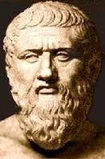Time, Motion and a Deterministic World
 Conventional modern physics has a basis in equations of motion to model the particles and forces of matter and energy. These equations tell you where a particle is (or in the case of Quantum Mechanics, the probability of a particle being somewhere) at a particular time. For example, The equation of an ellipse is used to show the orbit of a planet. Plug in the time and out comes the exact location of the planet.
Zeno of Elia
The difficulty with using equations to describe motion was first laid out in a paradox by Greek philosopher Zeno of Elea (ca. 490–430 BC) as Aristotle (ca. 384–322 BC) recounts:
Conventional modern physics has a basis in equations of motion to model the particles and forces of matter and energy. These equations tell you where a particle is (or in the case of Quantum Mechanics, the probability of a particle being somewhere) at a particular time. For example, The equation of an ellipse is used to show the orbit of a planet. Plug in the time and out comes the exact location of the planet.
Zeno of Elia
The difficulty with using equations to describe motion was first laid out in a paradox by Greek philosopher Zeno of Elea (ca. 490–430 BC) as Aristotle (ca. 384–322 BC) recounts:
In a race, the quickest runner can never overtake the slowest, since the pursuer must first reach the point whence the pursued started, so that the slower must always hold a lead.
You can never get anywhere because in half the time you will only be half way there. The paradox highlights the notion that the concepts of time and motion are never properly and completely defined.
In addition to the time and motion paradox, is the problem of a deterministic world. Is everything that happens in the future, pre-determined by what has happened in the past? The exact nature of mathematical equations leads to the conclusion that either the world is deterministic, or probabilities must be introduced (as in quantum physics). “Does God play dice?”
Animated Physics is Different
Animated physics offers an alternative to the understanding of conventional modern quantum physics. Here we use a fixed grid and fixed time steps, similar to frames in a movie, to model the particles and forces of matter and energy. You must run the animation for a period of time find out where a particle is at that time. You are not allowed to change the time frame or grid spacing while an animation is running. The grid provides the standard rulers and clocks to measure the world. Distorted grids can be displayed within the grid, but the grid itself does not change. The animations are used to calculate behavior over time to better understand the world around you.In animated physics you will never know exactly where things are. Your ability to determine the motion of particles is limited by the time and grid spacing you decided on before the animation is started. The world becomes increasingly “fuzzy” in an animated world as calculation errors caused by the selection of time and grid spacing start to accumulate. The world of animated physics is not deterministic. There is always a time and grid spacing smaller then the one you choose that could contain additional hidden variables.
How it started
A long time ago and with the confidence that I could understand the world, I started animating the orbit of earth around the sun. I was using using starting points (x/y/z) and how fast they are moving (mx/my/mz). So I setup the earth at 93,00,000 miles from sun and predicted how fast it was moving in one day. Much like setting up gun on the surface of the world and seeing how fast the bullet would have to go to make it around the world. From there, I ran the animation using the calculation of gravity force (fx=m1*m2/r^2, same applies to fy/fz) plus the old movement to get the new movement (mx=mx+fx) and new position (x=x+mx). And done.Now you line up your earth (mx/my/mz) like aiming a gun to shoot the earth around the sun in one year. It took some time, but sure enough, if I aimed careful enough, I could get the earth orbiting the sun in daily steps (timesteps=daily) in about 365 and 1/4 days. It also had about the correct farthest point on the orbit (aphelion) and the closest point on the orbit (perihelion).
Now, to make it more accurate, I thought, lets make our timesteps every hour. So I divided the mx by 24 (mx/24) and re-ran the animation. Unfortunately, the earth crashed into the sun (timesteps=hourly). In fact, if I changed the timesteps to monthly instead of daily by multiplying by 12 (mx*12), the earth flew off into space (timesteps=monthly). This led to the discovery of a very important point. You cannot change the timeframe of an animation while running the animation, without re-running the animation from the start using the new timesteps to calculate the new values of mx. ( I later discovered that this problem is equivalent to the famous 3-body problem).

